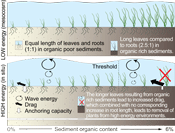Sediment organic content, hydrodynamics, and seagrasses

Caroline Wicks, from
EcoCheck, was first author on a paper published in
Marine Ecology Progress Series (378: 71-80), describing the effects of sediment organic content on seagrass growth and distribution in Chincoteague Bay, Maryland. When organic-rich sediments are found in hydrodynamically active areas, a mismatch occurs between plant morphology and the physical environment, leading to the loss of seagrasses due to uprooting. Therefore, sediment organic content limitations in seagrass habitats need to be evaluated within the local hydrodynamic settings. Fine organic sediment may be less limiting to seagrasses in quiescent waters while sand with low organic content may be required for seagrass survival in hydrodynamically active areas.
 Caroline Wicks, from EcoCheck, was first author on a paper published in Marine Ecology Progress Series (378: 71-80), describing the effects of sediment organic content on seagrass growth and distribution in Chincoteague Bay, Maryland. When organic-rich sediments are found in hydrodynamically active areas, a mismatch occurs between plant morphology and the physical environment, leading to the loss of seagrasses due to uprooting. Therefore, sediment organic content limitations in seagrass habitats need to be evaluated within the local hydrodynamic settings. Fine organic sediment may be less limiting to seagrasses in quiescent waters while sand with low organic content may be required for seagrass survival in hydrodynamically active areas.
Caroline Wicks, from EcoCheck, was first author on a paper published in Marine Ecology Progress Series (378: 71-80), describing the effects of sediment organic content on seagrass growth and distribution in Chincoteague Bay, Maryland. When organic-rich sediments are found in hydrodynamically active areas, a mismatch occurs between plant morphology and the physical environment, leading to the loss of seagrasses due to uprooting. Therefore, sediment organic content limitations in seagrass habitats need to be evaluated within the local hydrodynamic settings. Fine organic sediment may be less limiting to seagrasses in quiescent waters while sand with low organic content may be required for seagrass survival in hydrodynamically active areas.

